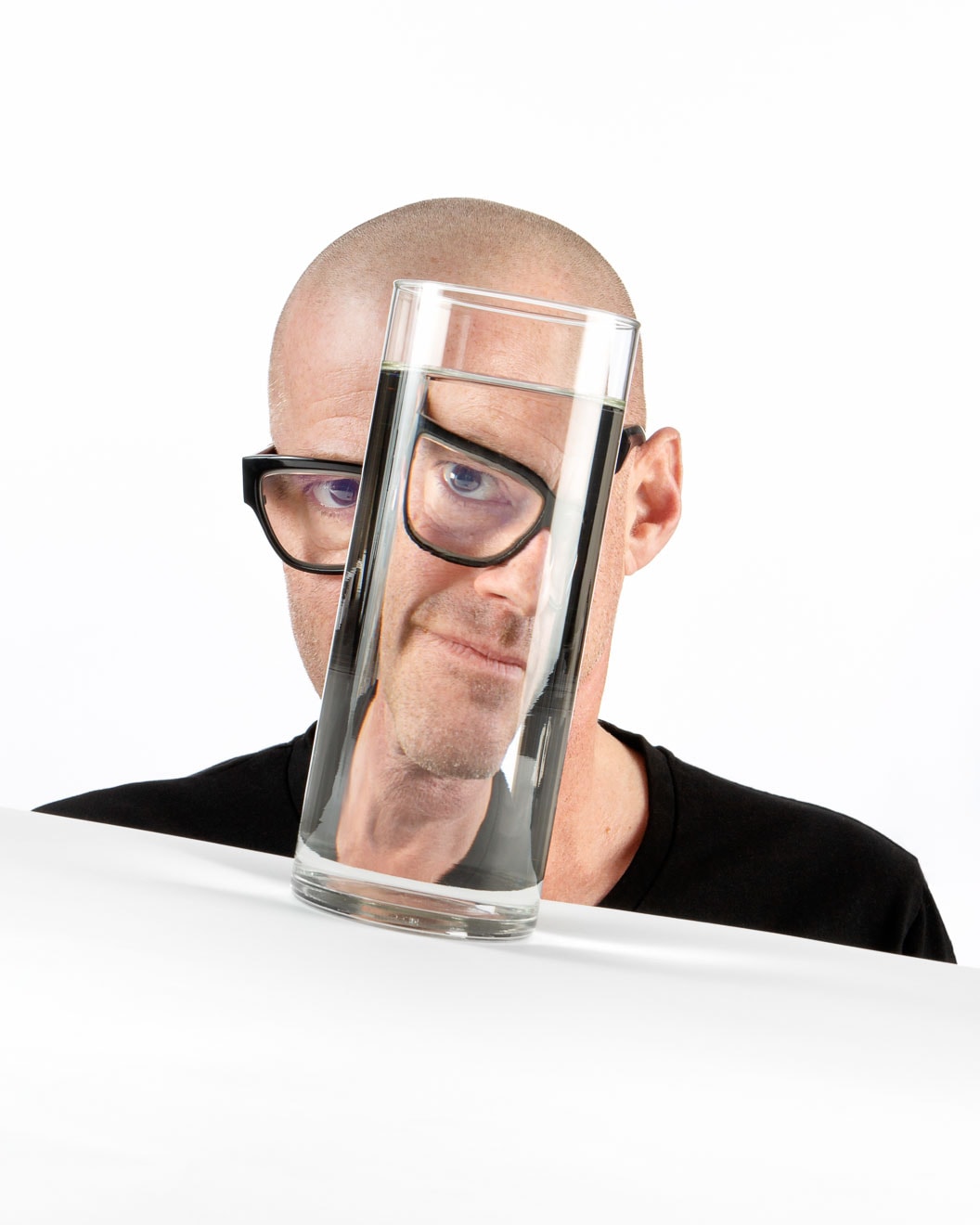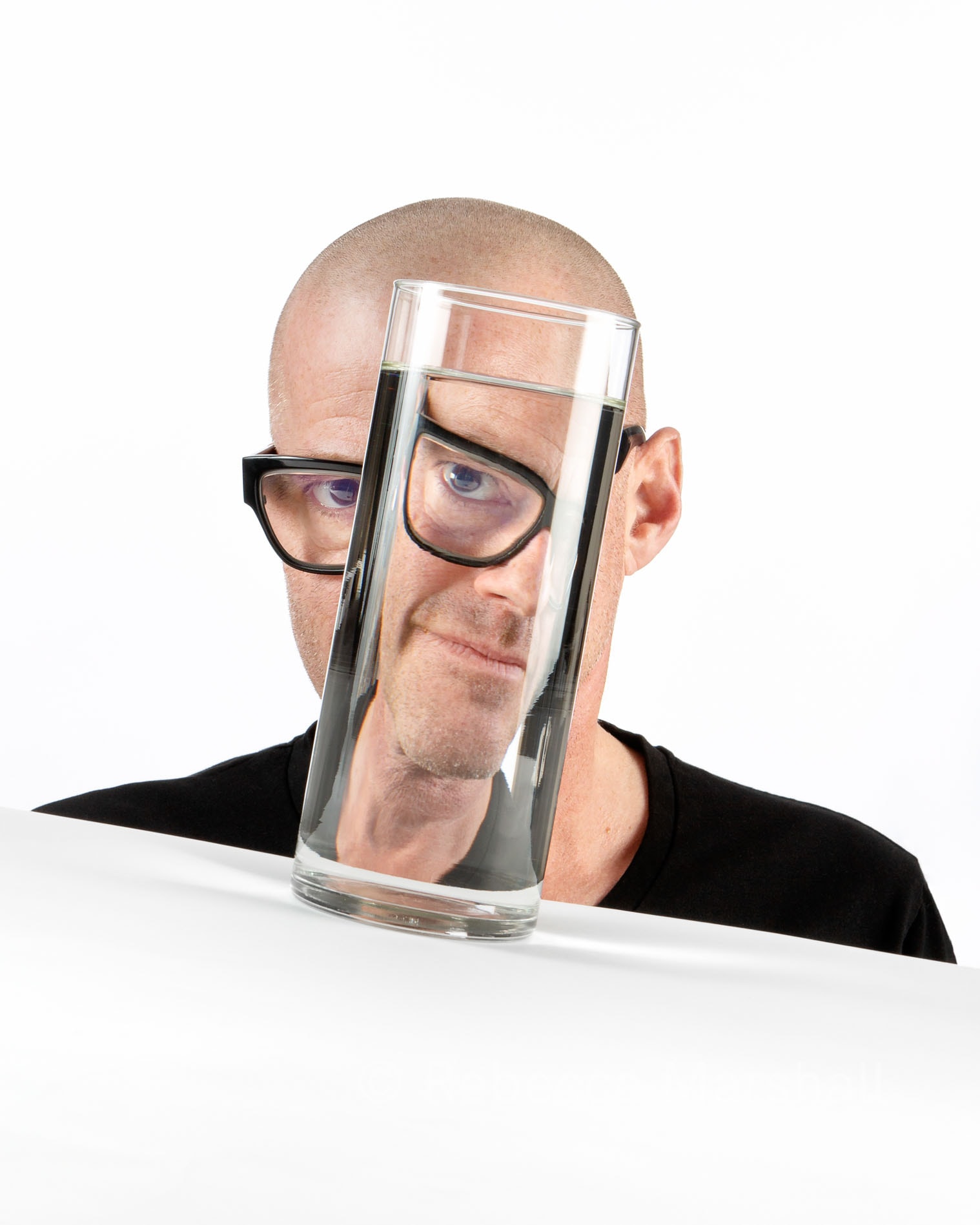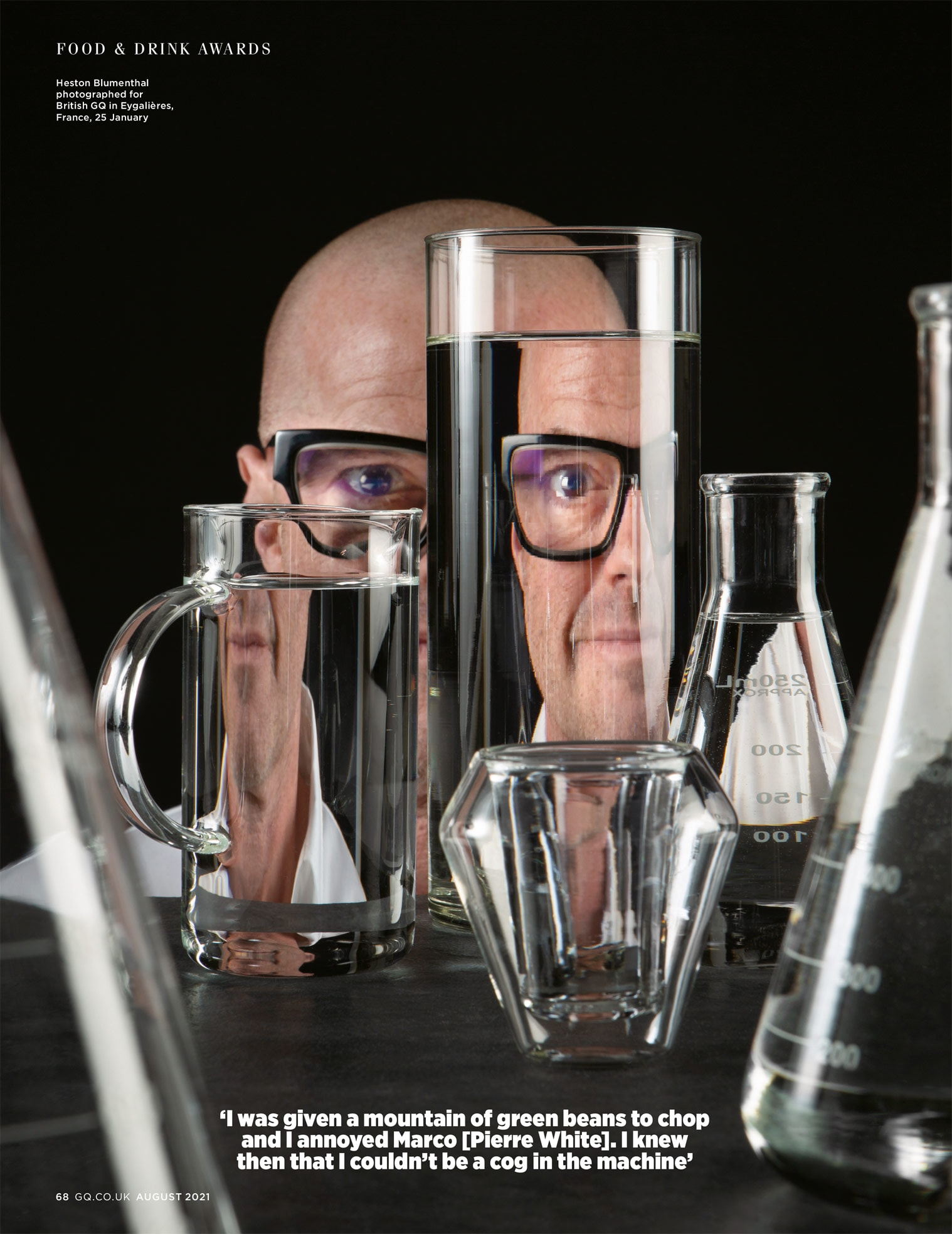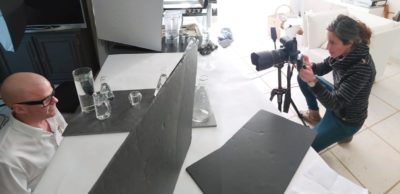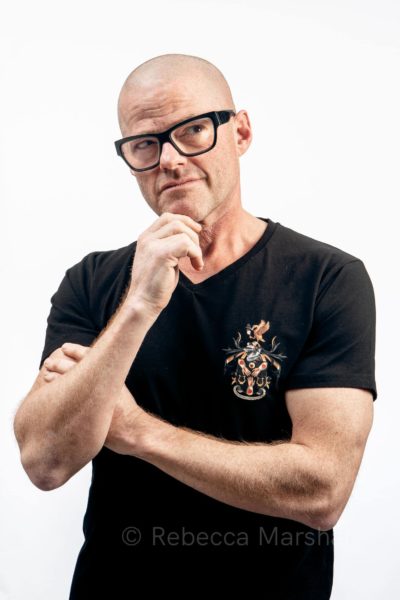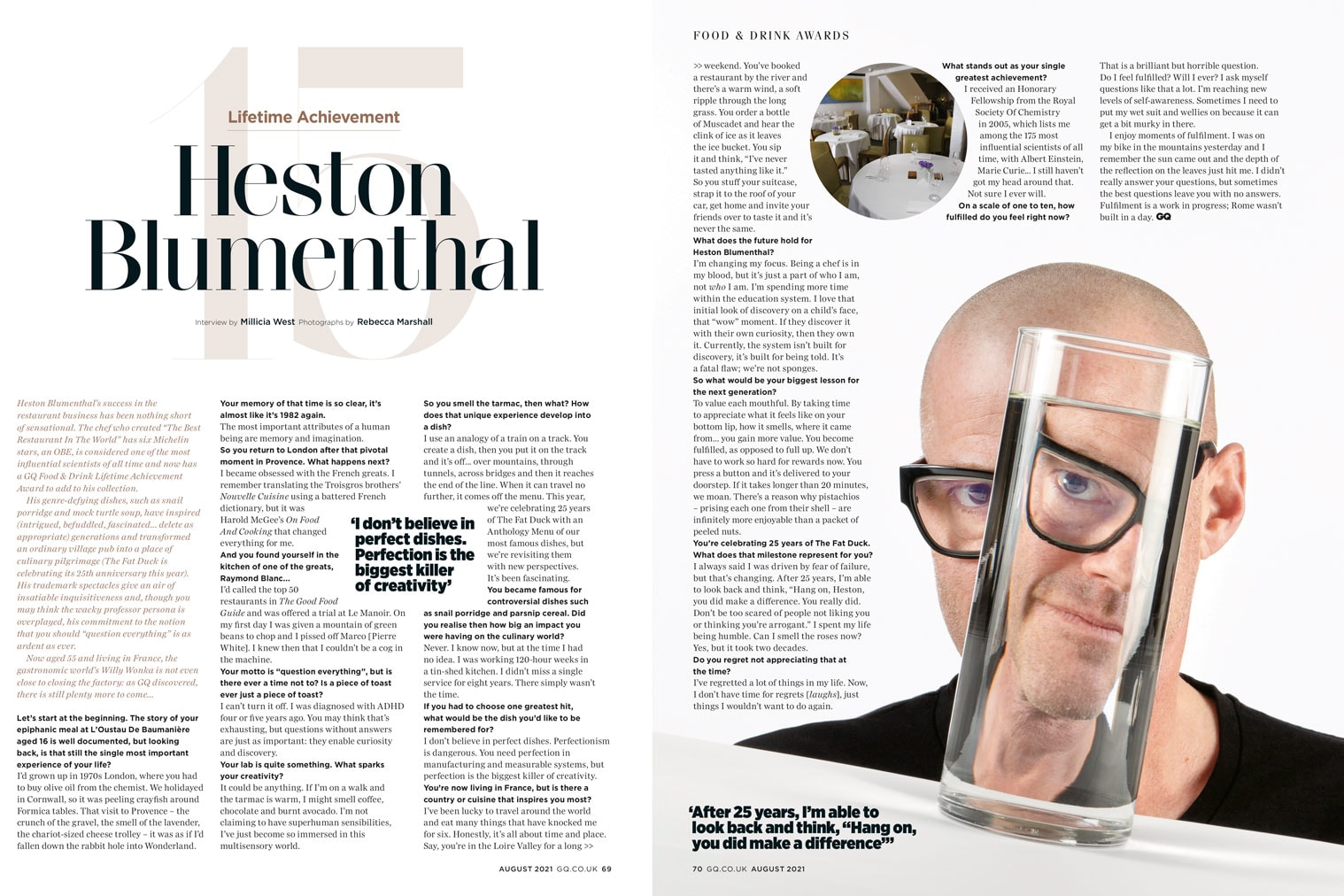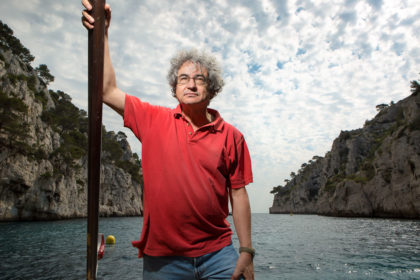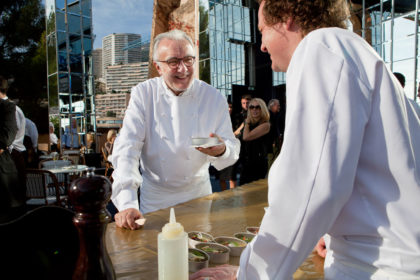“Love makes the rice go light and fluffy. If the rice is hated, it fluffs up a lot less. But you know what makes the worst rice? Indifference”
I’d been commissioned to make a portrait of Britain’s most acclaimed chef for GQ magazine and he was giving me a tour of his experimental kitchen. What I learned there was quite astonishing.
Snail porridge
Heston Blumenthal is no stranger to the spotlight. Boasting an OBE and several Michelin stars, Heston was awarded GQ’s Food & Drink Lifetime Achievement Award this summer. Known for controversial creations like snail porridge and bacon and egg ice cream, the celebrity chef owns the Fat Duck, once rated the best restaurant in the world. Today Heston, whose childhood experience of a South of France gastronomic restaurant was to inspire his future, lives in Provence.
A few weeks before the shoot, I had a meeting with the GQ art direction team in London. My portrait was to reflect the unique mix of science and invention that Heston brings to his cuisine (he is the only chef to be an Honorary Fellow of the Royal Society of Chemistry). However, it would be a challenge for a photographer in the South of France to source the props that the magazine had in mind for me to use. Our mood board involved a goldfish bowl, a bizarre-looking clamp with several arms, a knife big enough to chop the head off a bison and a robotic arm. Without thinking it through, I also suggested adding live snails to the portrait, but fortunately, while GQ and the PR agency liked the idea, we later received word from Heston’s team that escargots were yesterday’s news, doubtless saving me from a world of pain to find, direct and photograph snails.
Butcher to the rescue
Where would I find the unusual props though? I didn’t have to think for long. From sourcing rare cuts of meat and answering urgent cooking questions to once loaning me a large dagger when I went camping solo (“you never know what you’ll meet in the mountains”), local butcher Jean-Luc seems to have a solution, or a sharp tool, for every problem in life. Heston is one of the few non-native chefs to be well-known in France (a judge of French Top Chef) and Jean-Luc nodded sagely at the mention of his name. Before I knew it, he had rummaged around and produced: a bizarre-looking clamp with several arms; a knife big enough to chop the head off a bison; and a brand new molecular cuisine kit. “Try not to cut yourself – and show me the portraits afterwards!” was all he asked, as I left the shop. Meanwhile, GQ colleagues arranged for a goldfish bowl and scientific beakers to be sent from London (and the robotic arm was never mentioned again).
Distortion and reflections
I photographed a series of portraits through reflections in glass recently, but I’d never made a portrait through liquid held in a glass container. Anyone who has visited a hall of mirrors knows something about distortion and, when I began testing, I learned a lot more. The magazine’s art director was keen for me to photograph Heston through a large lab beaker, but I quickly realised how unflattering that would be, as the size of the lower part of Heston’s face, his mouth and chin, would be exaggerated, while his eyes would appear small (and there was nothing pleasing about the effect of a big, round goldfish bowl). Any tiny movements of Heston’s head, too, (how close different sides of his face were to the glass) would change his appearance significantly.
I began to add other glass containers to my home test set-up and became befuddled to see the right eye of my long-suffering ‘model’ friend reflected on the opposite side, while his nose popped up in another glass entirely. It was all getting rather Picasso and I hadn’t even started tackling the reflections created by my flashlights in the ultra-reflective surfaces of the glass (and, presumably, on Heston’s hairless head). To top off this list of factors-to fry-a-photographer’s-brain, I’d have Heston’s own glasses to deal with, a fashion signature that I knew he wouldn’t take off. Not only would they add another layer of glass to distort and reflect, but the black frames, particularly thick, could block the flash light and cast black shadows across his eyes. I didn’t know yet that his lenses darken in bright light. I was glad that I didn’t have unruly snails to add to the mix.
Kebab before the king
In his beautiful corner of Provence, between Aix and Avignon, Heston has a house in which he lives – and a second house, just down the road, which serves as his experimental food lab and team HQ. My assistant François and I had had a long drive from Nice and decided to stop for brunch at the only ‘restaurant’ open in the last village. I’m not sure what the king of molecular cuisine would’ve said if he’d known that, minutes before our arrival, we’d each put away a large kebab and fries, but we didn’t mention it and our day’s gastronomic quality dramatically improved with what François claimed to be the best coffee he’d ever tasted (Heston’s own brand, sourced personally from a far-flung country, in a coffee machine he’d had designed).
The kitchen, though large and beautiful, was full of light from wall-to-wall windows so I didn’t consider setting up for Heston’s portrait there. I needed a space to transform into a studio and so decided to take over a darker lounge instead. François and I set to, blacking out windows, ironing cloth, setting up backdrop and lights and preparing the props, carefully putting on gloves to handle and clean the glass (I’d witnessed when testing just how visible any dust and fingerprints would be). It was a couple of hours before Heston could join us.
Purple carrot and Tibetan bowls
Heston mountain bikes to work and lifts weights of 17 kg (I asked – both bike and dumbells were in the lounge). Clearly as much a man of action as he is a man of ideas, he understood the requirements of a portrait photographer and patiently held the sometimes awkward positions that I asked of him, moving his head by a few millimetres when required. He didn’t want to use a couple of the props I’d brought, but expressed delight at a rather wonderful purple carrot I’d found, and it was a good job I’d brought a few food items for some set-ups because, surprisingly, there seemed remarkably little that was edible in his ‘house of experiments’. Instead, I was intrigued by the rows of Tibetan singing bowls and jars of raw rice grains in water that I saw, with word labels like ‘love’ and ‘hate’ written on them. Heston graciously indulged my curiosity – and blew my mind.
Happy water
I’d come across the work of Japanese author Masaru Emoto some time ago. This controversial ‘pseudo-scientist’ asserted that the molecular structure of water is altered by human consciousness and I’d marvelled at the macro photography that had ‘proved’ his point. Emoto had chanted soothing, positive words at samples of water and frozen them. Photographs of the water crystals formed showed “happy water” to have quite a different structure from water that hadn’t been talked to. Heston, fascinated, had started experimenting in earnest, and began by acquiring the now deceased Emoto’s microscope.
On something of a lifelong quest to push the boundaries of the art and science of taste, Heston is a powerhouse of curiosity, ideas and knowledge. As we talked, he jumped from the physicist Carlo Rovelli (see his portrait), principles of sacred geometry and mindfulness, to how microbiome activity influences our emotions… before coming back to the hot topic of whether emotions can change the structure of water. Our bodies are 70% water; all food has water content in it. I started to see what potential such groundbreaking ideas could have for the work of this gastronomic pioneer.
Singing ice cream
The tests carried out by Heston and his team have been extensive. They’ve subjected water to gratitude, love, hate; played it music; showed it signs. They’ve witnessed afterwards, in frozen samples, the beautiful, sparkling crystals of water which had been exposed to soothing music – and the malformed, dull crystals of ‘abused’ water. They’ve used different methods: writing emotion words (like the labels on the jars of rice I’d seen); speaking them out loud; speaking them silently. Heston admitted that not all his team members feel cool about silently telling a bowl of rice that it is loved, but he is excited about the findings overall. He told me to try it myself – pour water into a Tibetan singing bowl, strike the bowl for long enough and apparently the water visibly thickens. “We’ve made ice cream with milk subjected to singing bowls and you can taste the difference”.
Optical illusion
The portrait eventually chosen to lead the article was from one of the simplest set-ups: Heston, sitting straight, looking through a simple, tall glass of water on a slanted table. Yet look closer and you quickly realise it is a straightforward optical illusion. The water level is slanted too. This is not a complex effect created in Photoshop – I directed Heston to sit at an angle, paid close attention to his shoulders and the angle of his head, then simply rotated the picture slightly afterwards.
It was late by the time I got back home to the French Riviera after the shoot and I was hungry. Inspired though I may have been by a myriad of new ideas about taste, I opened the cupboard and took out the first tin I saw: a supermarket cassoulet. I doubt that its water content had seen much love, but I said that I loved it a couple of times as I heated and stirred it, and perhaps, just perhaps, it tasted a fraction better for it…
> See Portrait portfolio
